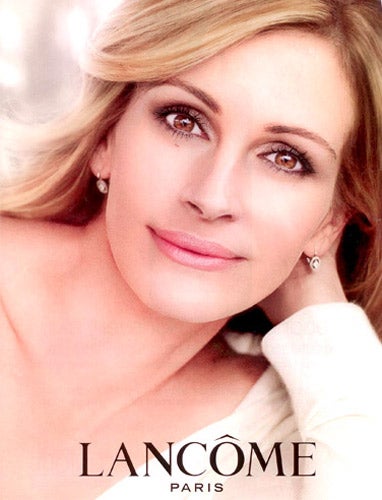L'Oréal ads banned over 'airbrushing'
Cosmetics company argue the flawless image of Julia Roberts was inpart because of the film star's naturally healthy and glowing skin

Every woman can enjoy flawless skin like Christy Turlington and Julia Roberts, the L'Oréal adverts promised. But in a significant victory in the battle against "airbrushing", the cosmetics giant has been forced to withdraw this claim after a watchdog found that consumers had been misled by images of the stars which had been digitally manipulated.
The Advertising Standards Authority (ASA) upheld a complaint by Jo Swinson, the Liberal Democrat MP, who claimed the retouched images misled consumers by exaggerating the results the beauty products could achieve. The advert featuring the supermodel Turlington promoted the Eraser foundation, created by the L'Oréal brand Maybelline, which promised to conceal crow's feet and leave "flawless-looking perfection".
Maybelline admitted the image had been "digitally retouched" to lighten the skin, clean up make-up, reduce dark shadows and shading around the eyes, smooth the lips and darken the eyebrows. Maybelline argued that despite the techniques used, the "image accurately illustrated the results the product could achieve".
But the ASA found the area around the model's left eye had been "digitally retouched to draw particular attention to the product's effect in this area". The advert was "likely to mislead", the ASA found. The watchdog reached the same conclusion over a double-page magazine advert for Teint Miracle foundation by L'Oréal's Lancôme, featuring a Mario Testino image of the actress Julia Roberts. The product promised to be the "first foundation that recreates the aura of perfect skin".
Lancôme said the flawless skin in the image was in part due to Julia Roberts' naturally healthy and glowing skin, and supplied pictures of her on the red carpet to support that claim. But Ms Swinson believed the flawless skin was the result of digital manipulation. The ASA found the "image was produced with the assistance of post-production techniques". L'Oréal refused to supply the original image of Roberts to the watchdog.
The ASA said it "could not conclude that the ad image accurately illustrated what effect the product could achieve, and that the image had not been exaggerated by digital post production techniques". Both misleading adverts must now be withdrawn.
Ms Swinson, the co-founder of the Campaign for Body Confidence, said: "Christy Turlington and Julia Roberts are naturally beautiful women who don't need retouching to look great. This ban sends a powerful message to advertisers – let's get back to reality."
Join our commenting forum
Join thought-provoking conversations, follow other Independent readers and see their replies
0Comments